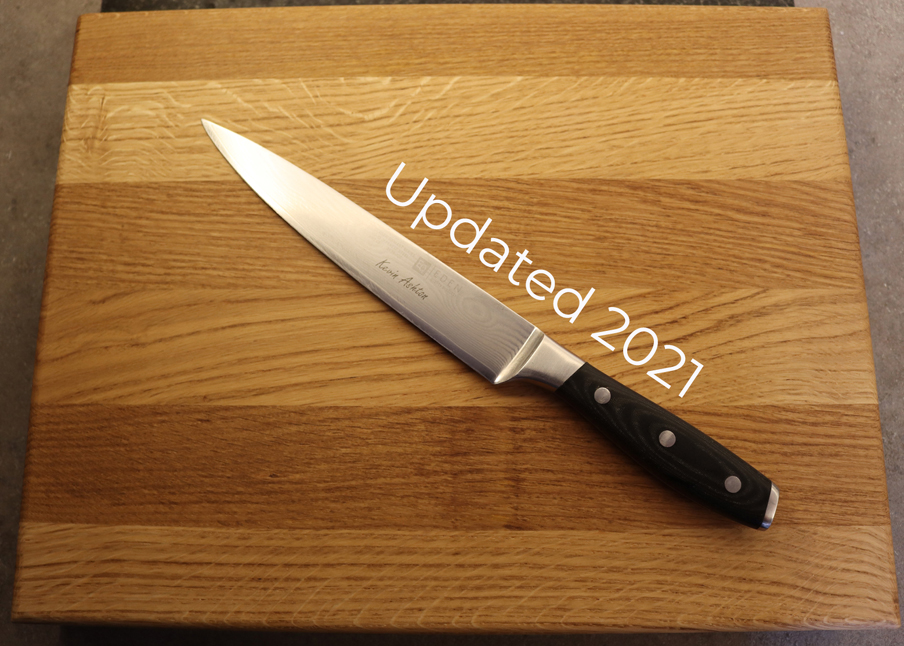 When I first got into the business, professional chefs and culinary colleges in the UK used wooden cutting boards. But someone decided that wooden boards were not hygienic and decided to replace them with plastic ones, and so the plague of plastic cutting boards began.
When I first got into the business, professional chefs and culinary colleges in the UK used wooden cutting boards. But someone decided that wooden boards were not hygienic and decided to replace them with plastic ones, and so the plague of plastic cutting boards began.
In the last few years, however, wooden boards have begun to regain popularity because several University studies have shown that bacteria actually grows slower on hardwood boards than plastic. This is because hardwood has a natural antibiotic property.
Basically, wooden cutting boards kill bacteria. Wood binds up water which bacteria needs to grow. Wood also contains antimicrobial compounds (given that many other plants can be used as natural antibiotics, this is not entirely surprising). Oak showed the highest decrease rate in bacterial titre, followed by beech and ash.
Types of Hardwood
There is a test of wood hardness called the Janka Test but for most people, it is more complicated than the casual observer needs.
Which woods are used for cutting boards can depend on the area of the world you live in; in America, chefs tend to favour Sugar Maple, in Europe we use a variety of hardwoods including Beechwood, White Oak and Rubberwood (also called Malaysian Oak). Ranging from inexpensive Rubberwood or Beechwood up to Teak and American Sugar Maple.
Bamboo
Just to clarify, bamboo is not wood it is a type of grass. The recent fashion of bamboo cutting boards just ‘muddy’s the water’. The seller’s claim it is sustainable, what they don’t tell you is that because Bamboo isn’t a wood, over time the fibres of the bamboo will break off and possibly get into your food. Some bamboo boards are glued together using phenol formaldehyde resin, which can be toxic until cured.
Size Of Your Cutting Board
Since you can not put your wooden cutting board into the dishwasher, you need to wash it by hand. Therefore deciding what size to buy can depend on the size of your kitchen sink. You need to be able to at least get half of your cutting board in your sink to make it practical to clean it. So I suggest a size of about 40 cm (15 3/4″) in length and a depth of about 26 cm (10 1/4 “) and no thinner than 1.8 cm. This is big enough to be practical but still easy enough to manoeuvre to clean. If weight is not an issue then a thicker board that is 3-4 cm thick will last longer.
Types of Wooden Boards
Traditionally, the wood grain on a chef’s cutting ran its length, this was thought to be more hygienic and easier to clean. The other type used to be only found in a butcher’s shop and are often referred to as a ‘butcher block cutting board’. Butcher blocks are constructed using pieces of wood with the grain running down, and were only used in a butcher’s because they are cleaned differently. They were salted down to kill bacteria and then scrubbed down with a serious, wire brush to remove the dirty layer of wood.
Modern butcher block cutting boards may look attractive, but eventually the glue holding the squares together could come loose (from washing) causing the board to warp. Having the grain run downwards may also help the board absorb more water which you don’t want from a hygiene point of view.
To Stop Your Board From Slipping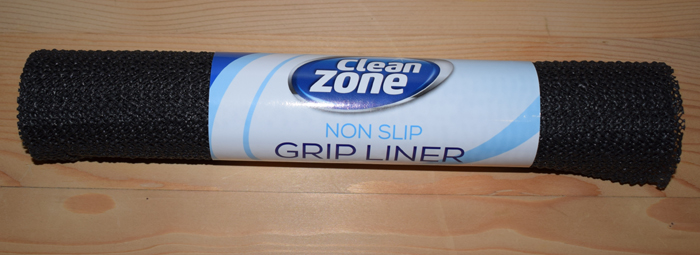
Don’t buy a board with rubber feet because that just stops you from using one side of the board. Instead, use something like this non-slip rubber mat, that you can cut to size and also keep clean.
Cleaning your Plastic Cutting Board
Plastic and wood have different characteristics, so you have to handle them differently. Plastic cutting boards can be placed in the dishwasher, where they can be sanitised by washing at high temperatures. However, I would still recommend that you first hand was hand wash the board to remove any food debris that might be hidden in the scars of the board before sanitising the board in your dishwasher. Do keep in mind that over time plastic cutting boards can warp in a dishwasher, causing them to not sit flat on your kitchen counter.
Cleaning your Wood Cutting Board
1.) Scrub the cutting board with hot clean soap and water (to get out any food debris in the scratches or grooves on the board’s surface).
2.) Sanitise the board using a mild bleach solution (1 Tbsp per gallon of cold water). I mix the solution and then pour some into a clean spray bottle a spray, leave for a couple of minutes then rinse well with clean water.
3.) Then pat off the excess moisture with a paper towel and allow to air dry completely (I like to place my clean board on my dish rack, or trivet to allow air to circulate around it).
Reviews
When I decided to write an article about the resurgence of wooden cutting boards I felt it was important to review a couple of boards myself. I did a lot of looking on the internet to try and find a few reasonably priced boards that I would be happy to use myself. I also read a lot of the information and tried to condense this into useful, but not overly long article. You can easily spend £60 to £120 on a large board which is unnecessary.
ChefRemi 4 stars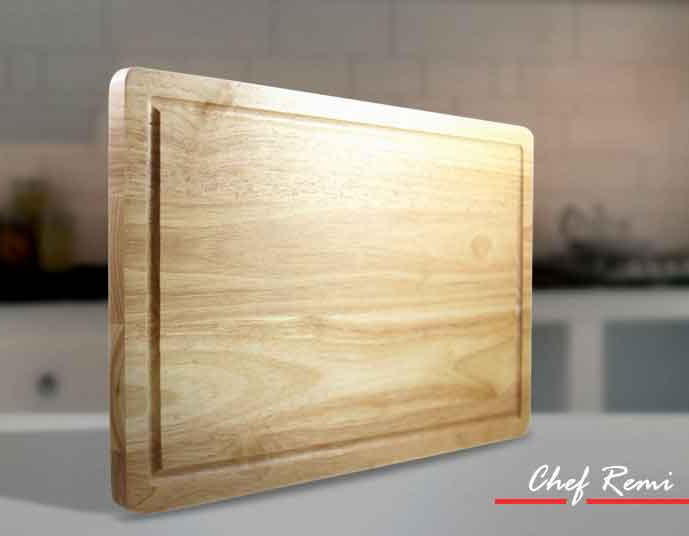
The Chef Remi company state their cutting board comes with a ‘100% Money Back Lifetime Warranty’, which says something about their quality and gives a first-time buyer some confidence in a growing market of cutting boards.
This rubberwood board measures 40cm x 25cm x 1.8 cm thickness
After using plastic boards both professionally and at home it was good to use a wooden board again. This board has a useful groove on one side to capture any liquid
and preventing it from getting onto your kitchen floor.
At £19.95 on Amazon, this might a good board for you, particularly if the weight of the cutting board is an issue and you want something light yet sturdy. The board has a protective coating that makes it easy to clean.
2021 Update:
White Oak Cutting Board 4.5 stars out of 5
From time to time I like to check the links I recommend to make sure the item is one, still available and two still a reasonable price. After realising the oak cutting I used to recommend, was not longer being sold, I hunted around for a new oak cutting board. My criteria was for it be made of hard wood, to be 40 cm x 30 cm in size (maximum size to fit in my kitchen sink ) and at least 35mm in thickness to prevent it from warping as it ages. I also wanted a board attractive enough to use in my YouTube channel
I also tried to find one that was made from solid oak planks not the oak staves you see in countertops, and people have starting creating cutting boards from these end cuts.
The handsome oak cutting board I chose (pictured above) to recommend after buying one and inspecting it thoroughly, you can find here on eBay. It currently sells for £30 plus £3.20 postage. It could be improved further if it was 40mm thick instead of 35 mm and if it had grooves milled into both sides (to act as handles) to make it easy to pick up. Never the less from a point of view of quality and competitive price I would definitely give this board high marks. You can if you wish order a custom size and thickness from this buyer at extra cost.
Mineral Oil
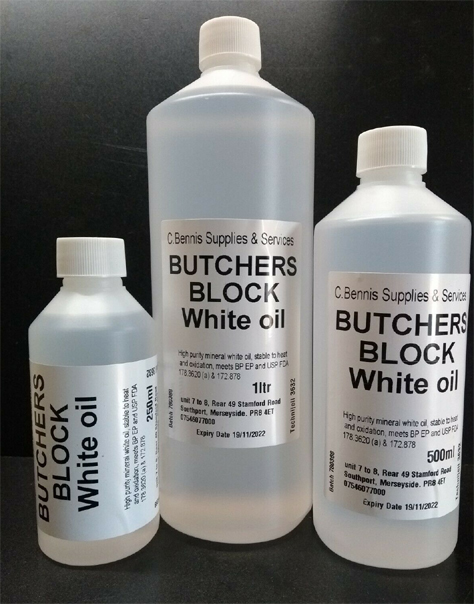
With all wooden cutting boards, it is important to rub them down from time to time, with food grade mineral oil to stop them from absorbing too much water when you are cleaning them. Food grade mineral oil can be relatively expensive, although during my research for this article I did discover that prices vary widely so shop around. Make sure the mineral oil is food grade. I found this one on eBay for UK readers. For American readers there are plenty of choice on Amazon. It is important to store the mineral oil in a cool dry place to prolong its shelf life, if the oil becomes rancid it will need to be replaced. I suggest a 250 ml or 500 ml bottle is plenty big enough (8oz 12 oz) for most people’s needs.
Conclusion
Good cutting board hygiene is the key whatever your cutting board is made of.
Plastic cutting boards over time absorb grease and no amount of runs through the dishwasher or scrubbing can remove all of the grease, plus the scarring and knife marks can potentially hold bacteria. Glass and ceramic can stay grease free but just like plastic they blunt your knives, which can create a different hazard. If you like cooking and keeping your knives sharp then it’s time you took a look and perhaps fall in love with wood. I now have 3 wooden cutting boards, so there is always one clean and ready to use.
Source material:
https://news.ncsu.edu/2014/09/cutting-boards-food-safety/
Sanitizing Cutting Boards
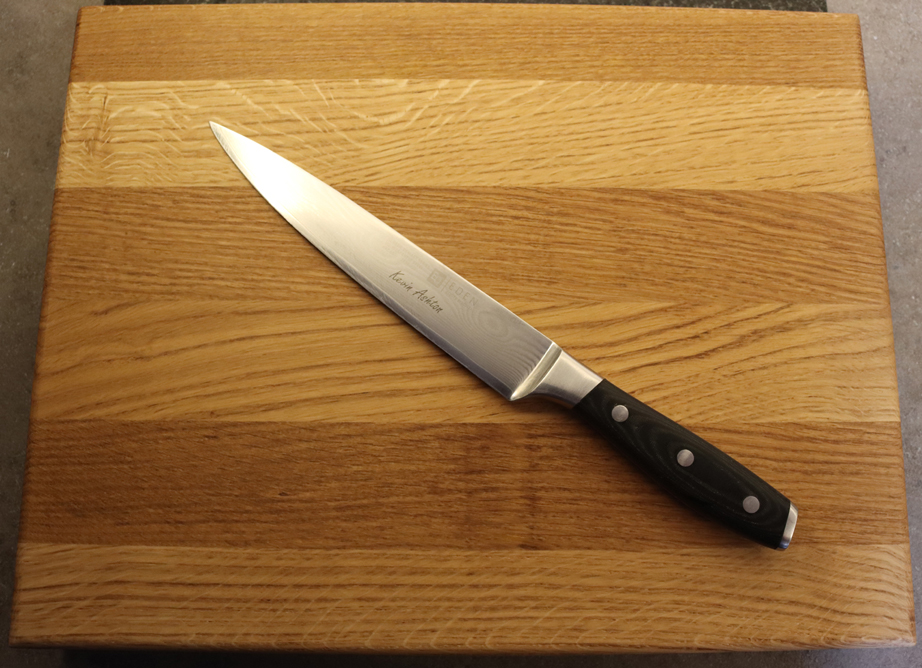
Great article Kevin, really interesting to hear your view on this. I love my big wooden chopping board I bought from Ikea years ago and it’s still going strong. Good to know you’ve done all the hard work for me to buy my next one. Thank you.
LikeLiked by 4 people
Thanks Janet for your kind words, they really are appreciated.
LikeLiked by 1 person
Informative, concise and well written.
LikeLiked by 2 people
Thank you for taking the time to give your feedback.
LikeLike
Amazing tips, thanks for sharing!
LikeLiked by 2 people
Thanks chef for your positive feedback, your kind words mean a lot. 🙂
LikeLiked by 1 person
whoa, this is handy. I didn’t know about not putting wood in the dishwasher. woops!
LikeLiked by 3 people
Glad to know my article helped. 🙂
LikeLike
Awesome 🙂
LikeLiked by 2 people
Thank you Aman 🙂
LikeLiked by 1 person
You are Welcome Sir 🙂
LikeLiked by 1 person
Great advice, that come handy, just in time to buy a new board. 🙂
LikeLiked by 3 people
Thank you, I’m glad my article is of use.
LikeLike
Very handy tips and recommendations from an expert
LikeLiked by 3 people
Thank you for your kind words of endorsement.
LikeLike
Great advice thanks you so much!
LikeLiked by 1 person
Thank Diane for your kind words.
Happy New Year.
LikeLiked by 1 person
You’re welcome and Happy New Year to you!
LikeLiked by 1 person
Very interesting and well written!! Thanks for the information
LikeLiked by 2 people
Thank you Alicia, for your kind words, they are appreciated.
Best Wishes
Kevin 🙂
LikeLiked by 1 person
Hey Chef Kebin,
I found all question’s answer I had I my mind about cutting board. Recently I used Bambo cutting board and you know what? I have same thought what you just said about the bamboo cutting board.
I also looked around your other blogs. All these stuff are amazing. I guess I will read your blog regularly.
Thank You
Gias
LikeLiked by 1 person
Thank you Gias, your kind words are appreciated.
Best Wishes
Kevin
LikeLike
Very informative post!
LikeLiked by 1 person
Thank you Twali, for your kind words of support.
LikeLike
I must admit that I’ve always preferred wood, though I can see the attractions of plastic in a professional environment.
LikeLiked by 1 person
Yes, the main attraction in the professional kitchen is cut down cross contamination by colour coding boards. But even so, in the end, it is down to the hygiene practices of the kitchen and the people who work in it.
If they are used correctly but then poorly cleaned and stored plastic boards can still be a hazard. Thank you so much for your thoughtful comment and reading my blog.
Best Wishes
Kevin
LikeLiked by 1 person
This article is really interesting.
Thank you for your suggestions
LikeLiked by 1 person
Glad you liked the article and the suggestions I made about cuuting board choices.
Best Wishes
Kevin
LikeLiked by 1 person
Yes, I love the wood ones!
LikeLiked by 1 person
Me too, much easier to keep clean and kinder to my knives.
LikeLiked by 1 person
❤
LikeLiked by 1 person
Fascinating, Kevin! Maybe it’s time to ditch the bamboo cutting board! Thanks for this helpful post! ❤ Happy holidays!
LikeLiked by 1 person
Glad you found my information about bamboo cutting boards useful.
LikeLiked by 1 person
One of the best and my favorite blog ever and best platform for interesting information.
LikeLike